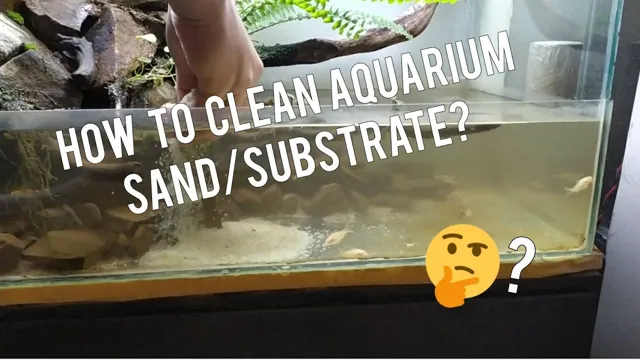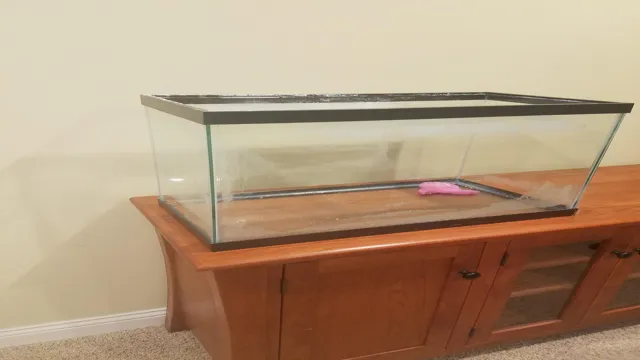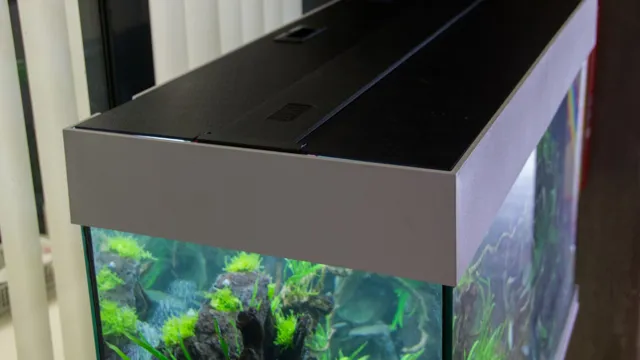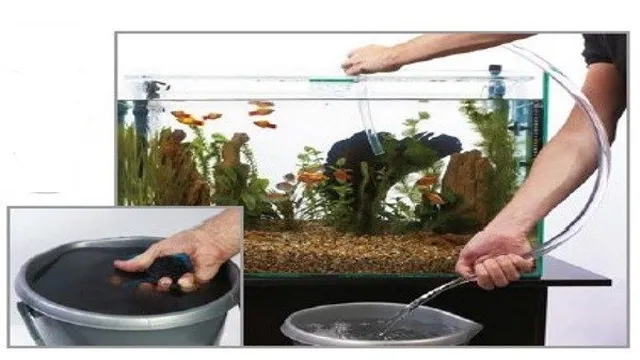Do you want to keep your aquarium’s sand substrate clean and healthy for your fishy friends? It may seem like a daunting task, but with the right approach, cleaning your sand substrate can be a breeze. Like any part of your aquarium, it’s important to keep the sand substrate free from debris and waste to maintain a healthy ecosystem. Sand substrates provide a more natural environment for your fish, but they also require cleaning to keep them looking pristine.
Taking a proactive approach to cleaning your sand will not only enhance the aesthetic appeal of your aquarium, but it will also help to prevent harmful bacteria, parasites, and algae growth. When it comes to cleaning your sand substrate, there are a few things to keep in mind. It’s crucial to use the right tools and take the proper precautions to avoid harming your fish or disrupting the balance of your aquarium.
From siphoning to cleaning and rinsing, we’ll guide you through the best practices for keeping your aquarium’s sand substrate clean and healthy. So, whether you are new to aquarium maintenance or looking for new ways to improve your existing routine, read on to discover our top tips for cleaning your aquarium’s sand substrate and creating a comfortable, healthy environment for your aquatic pets.
Materials Needed
If you have a sand substrate aquarium, it’s important to know how to clean it properly to maintain a healthy environment for your fish. To start, you’ll need some essential materials. Firstly, an aquarium vacuum will allow you to suction out the debris and waste that has accumulated in the sand.
You can also use a siphon or gravel cleaner to help with this task. A bucket is also necessary to collect the debris from the sand during the cleaning process. For thorough cleaning, consider using a sponge or scrub brush to break down any stubborn dirt that may have accumulated on the sand’s surface.
Lastly, get a water test kit to monitor important levels such as pH, nitrate, and ammonia, and a fish net for removing fish from the tank. With these materials, you’ll be able to clean your sand substrate aquarium effectively and ensure a healthy and happy environment for your fish.
Sand Sifter
If you’re looking for an easy and inexpensive way to sift sand, then a sand sifter is the perfect tool for you! You don’t need many materials to get started with this project. Here’s a list of everything you’ll need: – A large wooden or plastic frame (you can make your own or purchase one) – A piece of window screening or wire mesh (cut to the size of the frame) – A staple gun or nails and a hammer – Sand to sift Once you have all the materials gathered, it’s time to assemble your sand sifter. Begin by attaching the screening or mesh to the frame using your staple gun or nails.
Make sure it’s tightly secured and there are no loose edges. When it’s complete, use your sifter by filling it with sand and shaking it back and forth over a bucket or container. The sand will fall through the mesh, leaving any debris or larger materials behind.
Not only is a sand sifter a great tool for cleaning up your local beach, but it’s also a fun project to do with kids or as a DIY project on a lazy weekend. With just a few materials and a little bit of time, you can have your own sand sifter ready to go. So why not give it a try and see how it works for you? Your beach days will be much cleaner and more enjoyable!
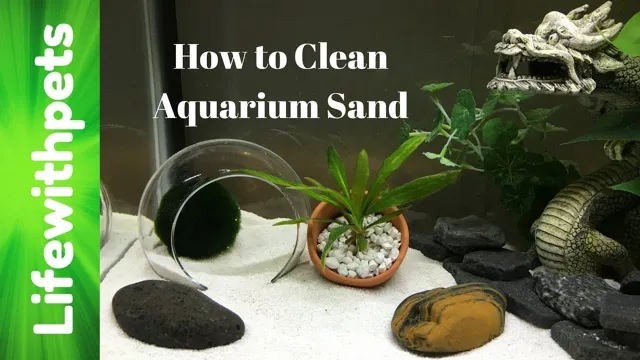
Bucket
To create a bucket, you need a few essential materials. First, you’ll need some sturdy metal or plastic for the body of the bucket. You can also use wood or other materials, but they’re not as common.
Secondly, you’ll need a handle that is attached securely to the bucket body for ease of carrying. Lastly, you need a lid to cover the bucket to protect its contents from the elements. Overall, the materials needed for a bucket are simple and easily accessible, making it a common household item that can be used for a multitude of tasks.
However, the quality of these materials will determine how durable and long-lasting the bucket will be and how well it will perform its intended use. Thus, choosing high-quality materials is crucial in ensuring that the bucket remains functional for an extended period.
Water Conditioner
If you’re considering installing a water conditioner in your home, there are a few materials you’ll need to prepare. First and foremost, you’ll need the conditioner unit itself. There are many different types and models of water conditioners on the market, each suited to different sizes and types of homes.
You’ll need to do some research to determine which one is right for you. In addition to the conditioner unit, you’ll also need some basic plumbing tools, such as a pipe cutter, wrenches, and Teflon tape. You may also need some PVC pipes and fittings, depending on the specific installation requirements of your chosen unit. (See Also: Is There an Aquarium in DC? Discover the Best Aquatic Attractions in the Capital City)
Finally, you’ll need to purchase some salt, which will be used to regenerate the conditioner unit as needed. Overall, the materials required for a water conditioner installation are relatively simple and straightforward, and many homeowners choose to tackle the project themselves.
Step-by-Step Guide
If you have a sand substrate aquarium, cleaning it can be an intimidating task. But don’t worry, it’s not as difficult as it seems. First, unplug any electrical equipment and remove your fish and plants from the tank.
Next, remove the dirty sand by using a siphon tube. Start by stirring the sand and then place the siphon tube above it, allowing the debris to be sucked up. Repeat this process until you’ve removed all the sand.
Then, rinse the sand thoroughly in a bucket until the water runs clear. Once the sand is clean, you can add it back into the tank. Lastly, replace the water, and add the fish and plants back in once it has been treated appropriately.
With these easy steps, cleaning your sand substrate aquarium is a breeze, and you’ll have a clean, healthy environment for your aquatic pets to thrive in.
Step 1: Turn off Filters
When it comes to taking photos, filters can be a great way to add some fun and flair to your shots. However, for editing purposes, it’s best to turn them off and examine the raw image first. This is especially true if you’re looking to do some serious editing or to correct any color imbalances.
The first step in this process is to turn off all filters and enhance the natural beauty of your photo. Doing this will allow you to get a better sense of the true colors and lighting in your shot, making it easier to make adjustments later on. By taking the time to do this, you’ll be well on your way to creating stunning images that accurately reflect your personal style and vision.
Step 2: Use Sand Sifter to Remove Debris
Once you’ve removed any large debris from your sand using a rake, it’s time to move on to the second step of the process: using a sand sifter. This handy tool is designed specifically to remove smaller bits of debris from the sand, ensuring that it’s as clean and safe as possible for anyone using your outdoor area. The process is simple: use the sifter to scoop up a small amount of sand, then give it a shake to let any debris fall through the mesh.
Repeat this process until you’ve sifted your entire sand area, then dispose of any debris that you’ve collected. By using a sand sifter, you’ll be able to achieve a pristine outdoor area that’s perfect for relaxing, playing, and enjoying some time in the sun. So don’t skip this important step – invest in a quality sand sifter today and enjoy your outdoor space to the fullest!
Step 3: Vacuum the Sand Substrate
When it comes to caring for your fish tank, vacuuming the sand substrate is an essential step. This helps to remove any excess debris, uneaten food, and waste that may have accumulated in the sand. Not only does this keep your tank clean, but it also helps to improve the water quality, which is vital for the health of your fish.
To vacuum the sand substrate, you will need a gravel siphon and a bucket. Start by placing the gravel siphon in the tank and gently moving it around the substrate. This will create suction, which will draw the water and debris into the siphon.
Allow the siphon to fill with water and debris, then slowly move it to the bucket. Repeat this process until you have vacuumed the entire substrate. Remember to be gentle and not disturb any fish, plants, or decorations while vacuuming.
By following this simple step, you can keep your fish tank clean and ensure the well-being of your fish. (See Also: How to Clean Aquarium Filter Pipes: Best Methods for Sparkling Results)
Step 4: Add Water Conditioner to the Tank
Water conditioner is a crucial element in maintaining a healthy aquarium for your fish. Once your tank is set up and filled with water, the next step is to add a water conditioner to ensure that the water is free from any harmful chemicals. These chemicals include chlorine and chloramine, which are commonly found in tap water and can harm your fish.
The water conditioner neutralizes these chemicals to make the water safe for aquatic life. It also adds essential minerals and vitamins that help to maintain the pH balance of the water. When adding water conditioner, it’s important to refer to the instruction manual for the right dosage based on the size of your tank.
It’s always better to use slightly less than recommended rather than more. Once the water conditioner is added, allow it to fully dissolve and circulate in the tank before adding any fish. By following this step, you’re ensuring a healthy and safe environment for your aquatic pets.
Tips for Maintaining a Clean Sand Aquarium
Maintaining a clean sand substrate aquarium is crucial for the health and well-being of your fish and aquatic plants. One key tip is to regularly vacuum the sand using a siphon to remove any debris, uneaten food, or waste that has accumulated. Additionally, it is important to only add the amount of fish and food that your aquarium can handle, as excess can lead to overfeeding and more waste.
To prevent harmful bacteria growth, make sure to clean any decorations or equipment in the tank on a regular basis as well. Another helpful tip is to incorporate substrate cleaners, such as snails or bottom-dwelling fish, to eat any organic matter that may be missed during cleaning. Overall, staying on top of cleaning and maintenance tasks will ensure a healthy and beautiful sand substrate aquarium for your aquatic pets to thrive in.
Tip 1: Do Regular Water Changes
Maintaining a clean sand aquarium is crucial to the health and wellbeing of your fish and other aquatic creatures. One important tip is to do regular water changes. This involves removing a portion of the water in your aquarium and replacing it with fresh water.
It’s important to test the water regularly to determine when a water change is necessary. Over time, fish waste and excess food particles can accumulate in the sand, which can lead to a buildup of harmful toxins and bacteria. Doing regular water changes helps remove these contaminants and keep the water clean and healthy for your fish.
Additionally, freshwater contains important minerals and nutrients that your aquatic pets need to thrive. By doing regular water changes, you can ensure that your sand aquarium remains clean and healthy, providing a safe and enjoyable environment for your fish to live in.
Tip 2: Don’t Overfeed your Fish
Maintaining a clean sand aquarium can be a challenge, but it’s essential for the health and happiness of your fish. One of the most important tips is to not overfeed them. It’s human nature to want to spoil our pets, but feeding them too much can lead to excess food waste, which can quickly dirty the sand, clouding the water and creating an unhealthy environment for your fish.
In addition, overfeeding can cause health problems for your fish, such as bloating and constipation. To avoid this, it’s best to stick to a regular feeding schedule and only give your fish the amount of food they need. If you’re concerned about underfeeding, try spreading out their meals throughout the day rather than feeding them all at once.
Remember, a clean sand aquarium is a happy aquarium!
Tip 3: Follow a Regular Cleaning Schedule
Maintaining a clean sand aquarium can be a tough job, but there are certain tips and tricks that can make it easier. One such tip is to follow a regular cleaning schedule. Establishing a routine makes it easier to stay on top of cleaning and ensures that your aquarium stays healthy and clean.
It’s important to keep in mind that each aquarium is different, and thus may require more or less cleaning depending on the animals and plants in it. Typically, it’s best to vacuum the sand once every two weeks to get rid of any leftover food, waste, and debris that have settled. Also, perform partial water changes once a week to help maintain water quality, which helps to keep your aquarium clean and free from harmful bacteria. (See Also: How to Build a Shelf in Aquarium Substrate: A Step-by-Step Guide)
By following these simple tips and creating a regular cleaning schedule, you can successfully maintain a clean and healthy sand aquarium. So go ahead, enjoy your aquarium, and keep it clean!
Conclusion
In conclusion, cleaning a sand substrate aquarium requires a bit of elbow grease, but with the right tools and technique, it can be done efficiently and effectively. Remember to vacuum the sand regularly, use a good quality filter, and keep an eye on your water parameters. And as always, don’t forget the most important step in any cleaning process: reward yourself with a little treat for a job well done (just not in the aquarium).
Happy cleaning!”
FAQs
Why is it important to clean a sand substrate aquarium?
It is important to clean a sand substrate aquarium because over time, uneaten food, fish waste, and other organic matter can accumulate and produce harmful bacteria that can harm your fish.
How often should I clean my sand substrate aquarium?
You should aim to clean your sand substrate aquarium once a week, or at least once every two weeks to maintain a healthy and clean environment for your fish.
What equipment do I need to clean my sand substrate aquarium?
You will need a siphon gravel vacuum, a bucket, and a clean sponge or cloth. You can also consider adding a water conditioner to remove any harmful chemicals in the water.
Can I use tap water to clean my sand substrate aquarium?
Yes, but make sure to dechlorinate the water first with a water conditioner to remove any harmful chemicals, as tap water can contain chlorine and other chemicals that can harm your fish.
How do I use a siphon gravel vacuum to clean my sand substrate aquarium?
Place one end of the siphon gravel vacuum in the aquarium and the other end in the bucket. Then, start siphoning the water out of the aquarium while simultaneously stirring the sand with the vacuum to remove any debris. Make sure to remove about 10-20% of the water during each cleaning.
Can I clean my sand substrate aquarium without removing my fish?
Yes, you can clean your sand substrate aquarium without removing your fish. However, try to work around them as much as possible to avoid causing them stress or harm.
How can I prevent my sand substrate aquarium from getting dirty quickly?
You can prevent your sand substrate aquarium from getting dirty quickly by feeding your fish the right amount of food and removing any uneaten food after a few minutes. You can also consider adding a filter to your aquarium to help remove debris from the water.

